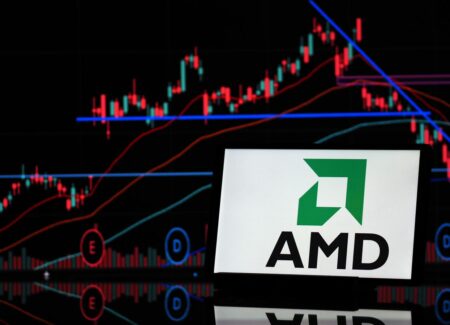As we all know the markets took a beating last week, driven by President Donald Trump’s tariffs announcement and retaliation by China. The S&P 500 fell by 10.5%, the Nasdaq by 11.4% and the Dow by 8.1% over two days, respectively. From Michael O’Rourke at Jones Trading (no relation), “The S&P 500 sell-off Thursday and Friday is among the worst two-day declines for the benchmark index in history. The move is only surpassed by the 1987 crash, the pandemic, and one of the many sharp declines during the Global Financial Crisis. In each of those instances, the S&P 500 continued to experience outsized volatility, but it did bounce notably over the next two weeks. The pandemic was the only “V” bottom among the episodes.”
The biggest question or concern is, “Has the market reached a low or will the sell-off continue?” One way to answer that question is to look at an equation that is used to determine a stock price or Index value:
Earnings x Multiple = Price
Earnings Component Is Exposed Downward
John Butters, vice president and senior earnings analyst at FactSet, wrote in his weekly analysis on Friday, April 4, that “during the first quarter, analysts lowered EPS estimates by a larger margin compared to the four most recent averages.” During the quarter March quarter’s EPS fell by 4.2% ($62.89 to $60.23) vs. the average of 3.3% for the past 20 quarters.
The year 2025’s full-year estimate dropped by 1.6% from $274.12 to $269.67 over the quarter. The projection has fallen from approximately $279 in late August last year.
Now that President Trump is imposing worldwide tariffs it is widely expected that earnings will fall. While there will be information provided with first quarter earnings announcements, there will still be a lot of unknowns. So here are projections based on percentage declines from $269.67.
- Each 1% decline is $2.70
- 2% = $264.28
- 5% = $256.19
- 7% = $250.79
- 8% = $248.10
- 10% = $242.70
Valuation Component Is At Best At Equilibrium
The S&P 500’s earnings multiple peaked at approximately 22.2x in early November last year. Butters estimates that is has fallen to 19.4x as of last Friday. This is below the five-year average of 19.9x and above the 10-year average of 18.3x. The S&P 500’s forward 12-month P/E ratio is now at 18.5x based on Tuesday’s close.
Uncertainty leads to lower valuation multiples and there is a lot of uncertainty in the economy and the markets, driven by President Trump’s actions, and not just his tariff policy. The number of executive orders that are essentially dismantling federal agencies and allowing DOGE to essentially lay off people add more layers to investors’ concerns.
Tariff Uncertainty Isn’t Going To Become Clear Anytime Soon
Unless President Trump announces some concrete and real tariff deals, and not hyperbole, it is hard to see how earnings and valuation both don’t fall. My thought is that Trump isn’t going to back down. Yes, there will be some wins, at least from an optics perspective, but especially with China neither Trump nor Xi wants to be the first to flinch.
Another tell from the administration is Vietnam. Vietnam offers zero tariffs and Trump administration says not enough. If the goal of the Trump administration is to get Vietnam to import as much as it exports that isn’t going to happen. In 2023 Vietnam’s GDP was $430 billion vs. the United States’ $27.4 trillion, or 1.5% the size of the United States. And the U.S. doesn’t make what Vietnam wants, while Vietnam makes what U.S. consumers wants.
O’Rourke’s Tuesday note included, “Today’s eye-opener that contributed to the negative equity market reversal was U.S. Trade Representative Jamieson Greer. Greer testified before the Senate Finance Committee regarding the President’s Trade Policy Agenda. Greer made many statements that should alarm investors.”
O’Rourke added, “This last exchange may be both the most telling and the most alarming. Senator Mark Warner asked Greer about the 10% tariff the Administration was applying to Australia. Greer responded, “We’re addressing the $1.2 trillion deficit, the largest in human history that President Biden left us with. We should be running up the score in Australia, they ban our beef, and they ban our pork…” At that point Warner cut him off and stated that the U.S. runs a trade surplus with Australia. It is a fairly sizable $17.6 billion surplus. If Australia applied the Administration formula, the U.S. surplus is 52.5% of U.S. exports to Australia, and they would charge us a 26% tariff.”
I’ve heard many stories about products on boats right now that will be much more expensive when they land and some already have price stickers on them.
Who eats the tariff cost? And if you reprice the products sales will more than likely be lower and margins will take a hit.
Earnings Times Valuation Equals Price
Current earnings of $269.97 times Tuesday’s valuation of 18.5x equals the S&P 500 Index value of 4,983 at the close.
These are S&P 500 values based on decreased earnings at the current 18.5x valuation.
- 2% = $264.28 = 4,883
- 5% = $256.19 = 4,734
- 7% = $250.79 = 4,634
- 8% = $248.10 = 4,584
- 10% = $242.70 = 4,484
These are S&P 500 values based on lower valuation at the current earnings of $269.97.
- 18x = 4,854
- 17x = 4,584
- 16x = 4,315
- 15x = 4,045
These are calculations on what the S&P 500 could fall to based on decreased earnings and lower valuations.
- 2% and 18x = 4,757 and down 4.7% from $4,983
- 2% and 17x = 4,493 and down 10.9%
- 5% and 18x = 4,611 and down 8.1%
- 5% and 17x = 4,355 and down 14.4%
- 7% and 16x = 4,013 and down 24.2% from $4,983
- 7% and 15x = 3,762 and down 32.5%
- 8% and 16x = 3,970 and down 25.5%
- 8% and 15x = 3,721 and down 33.9%
Markets Hate Uncertainty, Leading To Lower Prices
It is hard to build a case that earnings will move higher or that investors nerves will get better, which is needed for the markets to rebound. Probably the best-case scenario is the 2% drop in earnings and a small fall in valuation to 18 times earnings leading to only a further 4.7% drop. However, it is more likely that the S&P 500 Index will fall at least another 10% and it could be 20% or more.
Read the full article here
















